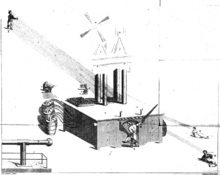Delusion
This one states that some of those persons who are predisposed might experience the onset of delusional disorder in those moments when coping with life and maintaining high self-esteem becomes a significant challenge.That they are needed to sustain certain delusions was examined by a preliminary study on delusional disorder (a psychotic syndrome) instigated to clarify if schizophrenia had a dopamine psychosis.[30] Similarly, in a series of case studies, delusions of guilt and punishment were found in Austrian patients with Parkinson's being treated with l-dopa, a dopamine agonist.Dysfunction in evaluations systems localized to the right lateral prefrontal cortex, regardless of delusion content, is supported by neuroimaging studies and is congruent with its role in conflict monitoring in healthy persons.[citation needed] The aberrant salience model suggests that delusions are a result of people assigning excessive importance to irrelevant stimuli.Studies on psychiatric patients show that delusions vary in intensity and conviction over time, which suggests that certainty and incorrigibility are not necessary components of a delusional belief.Psychiatrists rarely have the time or resources to check the validity of a person's claims leading to some true beliefs to be erroneously classified as delusional.Critics (such as R. D. Laing) have argued that this leads to the diagnosis of delusions being based on the subjective understanding of a particular psychiatrist, who may not have access to all the information that might make a belief otherwise interpretable.[38] This use of fiction to decrease the malleability of a delusion was employed in a joint project by science-fiction author Philip Jose Farmer and Yale psychiatrist A. James Giannini.This test includes appearance, mood, affect, behavior, rate and continuity of speech, evidence of hallucinations or abnormal beliefs, thought content, orientation to time, place and person, attention and concentration, insight and judgment, as well as short-term memory.[44] Although non-specific concepts of madness have been around for several thousand years, the psychiatrist and philosopher Karl Jaspers was the first to define the four main criteria for a belief to be considered delusional in his 1913 book General Psychopathology.[49] Delusions and other positive symptoms of psychosis are often treated with antipsychotic medication, which exert a medium effect size according to meta-analytic evidence.[51] A meta-analysis of 43 studies reported that metacognitive training (MCT) reduces delusions at a medium to large effect size relative to control conditions.[53][54] Anthropologist David Graeber has criticized psychiatry's assumption that an absurd belief goes from being delusional to "being there for a reason" merely because it is shared by many people by arguing that just as genetic pathogens like viruses can take advantage of an organism without benefitting said organism, memetic phenomena can spread while being harmful to societies, implying that entire societies can become ill. David Graeber argued that if somatic medicine did not have higher scientific standards than psychiatry's way of defining delusion, pandemics like the plague would have been considered to transubstantiate from an illness to "a phenomenon that benefits the people" as soon as it had spread to a sufficiently large portion of the population.It was argued by Graeber that since deinstitutionalisation made sales of psychiatric medication profitable by no longer needing to spend money on keeping the patients in mental hospitals, corrupt incentives for psychiatry to allege "needs" for treatments have increased (in particular with regard to medicines that are said to be needed in daily doses, not so much regarding devices that can be kept for longer periods of time) which may itself be a harmful memetic pandemic in society that leads to diagnosing and medication of criticisms of widespread beliefs that are actually absurd and harmful, making the absurd belief that is not labelled as an illness profitable anyway by attracting criticisms that are labelled as illnesses.
Delusion (disambiguation)Delusional disorderSpecialtyPsychiatryconfabulationillusionhallucinationperceptionpsychoticschizophreniaparaphreniabipolar disorderpsychotic depressiondepressivepsychoanalysisDelusional jealousyDelusion of guilt or sin (or delusion of self-accusation)Thought broadcastingDelusion of thought insertionPersecutory delusionsDelusion of referenceErotomaniaReligious delusionSomatic delusiondelusional parasitosisGrandiose delusionsomnipotentsupernaturalscience-fictionalreligiousPersecutory delusionpersecutedDSM-IV-TRquerulous paranoiageneticself-esteemhearingimmigrationhomovanillyl alcoholfrontotemporal dementiapsychosisLewy body dementiaaberrant saliencesalience networkdopamineAlzheimer's diseaseCapgras delusionsJames Tilly Matthewspsychiatric patientsMartha Mitchell effectattorney generalWhite HouseWatergate scandalR. D. LaingsubjectiveYale UniversityOhio State UniversityPhilip Jose FarmerRed Orc's RageAnthony DavidanxietyparanoiaappearancebehaviorconcentrationmemoryKarl Jaspersfigurativelyantipsychotic medicationmeta-analytic evidenceCognitive behavioral therapymeta-analysismetacognitive trainingessentialismempirical evidenceDavid Graebermemeticthe plaguedeinstitutionalisationpsychiatric medicationBizarre objectCotard's delusionClinical lycanthropyDeliriumDelusional misidentification syndromeFolie à deuxIntrusive thoughtsJerusalem syndromeMass hysteriaMonothematic delusionParis syndromePrelestReduplicative paramnesiaOnline Etymology DictionaryBortolotti LCurrent Psychiatry ReportsPsychological MedicineDiagnostic and Statistical Manual of Mental DisordersAmerican Psychiatric AssociationJaspers KMurray RMDiseasesDBDelusional disordersCotard's syndromeCryptic pregnancyDelusional companion syndromeIdeas and delusions of referenceIdée fixeParanoid anxietySomatoparaphreniaThought insertionThought withdrawalTruman Show delusionDelusionalmisidentificationCapgras delusionFregoli delusionIntermetamorphosisMirrored-self misidentificationSyndrome of subjective doublesDelusionalparasitosisFormicationMatchbox signMorgellonsMood disorderSpectrumBipolar I